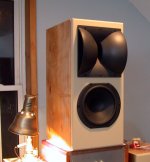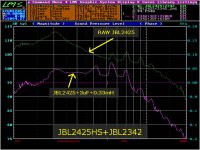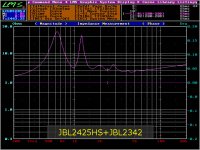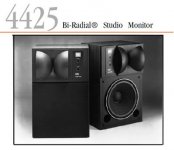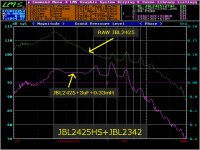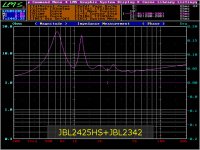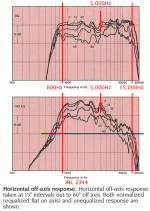Fun project. Turning the clock back 25 years, I first heard the JBL4425 in a recording studio. I remember vividly the unique shape of the horn which left a lasting impression. Since then, it has been one of my quest to work with this Bi-Radial Horn.
Unlike the original JBL4425 which had a JBL2416 compression driver, my JBL2342 horn is coupled to the JBL2425. And instead of a 12" woofer, I decided on an 8" Peerless 830869. This of course negates the essence of the JBL4425 which features physical alignment of the woofer and compression driver centers in the vertical plane. This is not an attempt to clone the JBL4425 but rather to examine the sonic performance of the horn combo with newer, modern woofers.
The 8" Peerless is chosen for it's extended range. Presently, the system is actively crossed at 2KHz (18dB/oct) with the Synergies. Passive components are used to voice the response.
How do they sound?
Overall, quite impressive. I like the JBL2342+JBL2425 combo. Smooth, no typical Titanium brightness. The Peerless 830869 is surprising. Though I loath crossing 8" at 2KHz, I'm able to do it and yet retain the vocals with this Peerless. And it goes down to 40Hz too. It'll be interesting to cross this woofer with a Dome tweeter at 2KHz. I'll leave that for another day.
I will attempt to cross the Horn lower later. The JBL4425 was crossed at 1.2KHz. At this frequency, it would not be a problem to replace the 8" with a 10". A good excuse for a future project.
Unlike the original JBL4425 which had a JBL2416 compression driver, my JBL2342 horn is coupled to the JBL2425. And instead of a 12" woofer, I decided on an 8" Peerless 830869. This of course negates the essence of the JBL4425 which features physical alignment of the woofer and compression driver centers in the vertical plane. This is not an attempt to clone the JBL4425 but rather to examine the sonic performance of the horn combo with newer, modern woofers.
The 8" Peerless is chosen for it's extended range. Presently, the system is actively crossed at 2KHz (18dB/oct) with the Synergies. Passive components are used to voice the response.
How do they sound?
Overall, quite impressive. I like the JBL2342+JBL2425 combo. Smooth, no typical Titanium brightness. The Peerless 830869 is surprising. Though I loath crossing 8" at 2KHz, I'm able to do it and yet retain the vocals with this Peerless. And it goes down to 40Hz too. It'll be interesting to cross this woofer with a Dome tweeter at 2KHz. I'll leave that for another day.
I will attempt to cross the Horn lower later. The JBL4425 was crossed at 1.2KHz. At this frequency, it would not be a problem to replace the 8" with a 10". A good excuse for a future project.
Attachments
Hi rjbond3rd
I'm no expert in horn design. Someone like Dr Geddes would be perfect in explaining the geometry of the Bi-Radials.
From what I found in wiki, Keele of JBL mated a JBL-style diffraction horn to a secondary horn consisting of exponentially-curved sides derived by using two radial formulas. This resulted in a hybrid constant directivity horn that was free from the distortion components associated with abrupt angle changes. More information can be found at Wiki Horn Loudspeaker
The advantage of the Bi-Radial is indeed the dispersion properties. The JBL2342/2344 exhibit a constant beamwidth of 100 degrees in the horizontal and vertical planes. Horizontally, frequencies extend up to 16KHz, whereas vertically is up to 12.5KHz. Quite an achievement. And all this in the 80s. What is even more amazing is that more the a quarter century later, these horns are still in use commercially.
I'm no expert in horn design. Someone like Dr Geddes would be perfect in explaining the geometry of the Bi-Radials.
From what I found in wiki, Keele of JBL mated a JBL-style diffraction horn to a secondary horn consisting of exponentially-curved sides derived by using two radial formulas. This resulted in a hybrid constant directivity horn that was free from the distortion components associated with abrupt angle changes. More information can be found at Wiki Horn Loudspeaker
The advantage of the Bi-Radial is indeed the dispersion properties. The JBL2342/2344 exhibit a constant beamwidth of 100 degrees in the horizontal and vertical planes. Horizontally, frequencies extend up to 16KHz, whereas vertically is up to 12.5KHz. Quite an achievement. And all this in the 80s. What is even more amazing is that more the a quarter century later, these horns are still in use commercially.
http://www.xlrtechs.com/dbkeele.com...S Preprint) - Monitor Loudspeaker Systems.pdf..explain the rationale behind the geometry of the JBL horn? ..
The Biradial horn stems more from what Don Keele was finding at his previous job at EV: that conical horns (straight sides) had more constant directivity and that horns of any curvature (exponential, etc) would have ever rising directivity. In addition, he found a common phenomonon of midrange narrowing where the beamwidth shrank at the lowest frequency where the dimensions were controlling directivity. He found that the diameter of the driver exit determined the highest frequency of constant directivity (the device beamed above that).
Putting it all together he found a way to flare the outter perimeter to fix the midrange narrowing, and, with the biradial style, form a narrow diffraction slot to give wide horizontal feed to the side walls. He had to break with the previous mindset that all horns should be exponential and that on axis flatness (rather than axial response following the power response of the compression driver) were best design criteria. The end result was much more constant directivity and extremly uniform polar curves.
Note that the only exponential section is the short linkage between the compression driver throat and the diffraction slot. The cutoff frequency of this exponential section is determined by the slot area and distance from throat to slot. You can make the slot too narrow and push the flare rate too low (somewhat choppy performance near cutoff will result). But if you balance all the parameters carefully the performance is very high indeed. The diagram in the linked to paper above defines the surface contours.
I haven't seen any device that performs better in terms of d.i. flatness or polar smoothness and uniformity since these particular models designed in the 80s.
David Smith
Putting it all together he found a way to flare the outter perimeter to fix the midrange narrowing, and, with the biradial style, form a narrow diffraction slot to give wide horizontal feed to the side walls. He had to break with the previous mindset that all horns should be exponential and that on axis flatness (rather than axial response following the power response of the compression driver) were best design criteria. The end result was much more constant directivity and extremly uniform polar curves.
Note that the only exponential section is the short linkage between the compression driver throat and the diffraction slot. The cutoff frequency of this exponential section is determined by the slot area and distance from throat to slot. You can make the slot too narrow and push the flare rate too low (somewhat choppy performance near cutoff will result). But if you balance all the parameters carefully the performance is very high indeed. The diagram in the linked to paper above defines the surface contours.
I haven't seen any device that performs better in terms of d.i. flatness or polar smoothness and uniformity since these particular models designed in the 80s.
David Smith
Hello David
Thank you for your input. I am having some difficulties comprehending the response of horns. I would appreciate your thoughts on them.
Take this JBL2342 for example. According to the JBL4425 specs, it is crossed at 1.2KHz. But when I swept the horn, there's this peak at 2KHz. From 2K to 15K, the slope is quite linear at about 6dB/oct. However, on the left of the 2KHz, the horn seems to be dying off. If one is to cross below 2KHz, like 1.2KHz, wouldn't the peak present a problem. Seems that it's common to cross before the peak. Even with the JBL2445, crossing at 500 to 800Hz is still on the slope.
The other issue I have is the impedance, or rather the resonance of the JBL2425 driver. It looks very much like a bass reflex, two peaks with a valley in between. If I am to assume that the valley is indeed the resonance (ie 1KHz), wouldn't crossing at 1.2K be too close.
Thank you for your input. I am having some difficulties comprehending the response of horns. I would appreciate your thoughts on them.
Take this JBL2342 for example. According to the JBL4425 specs, it is crossed at 1.2KHz. But when I swept the horn, there's this peak at 2KHz. From 2K to 15K, the slope is quite linear at about 6dB/oct. However, on the left of the 2KHz, the horn seems to be dying off. If one is to cross below 2KHz, like 1.2KHz, wouldn't the peak present a problem. Seems that it's common to cross before the peak. Even with the JBL2445, crossing at 500 to 800Hz is still on the slope.
The other issue I have is the impedance, or rather the resonance of the JBL2425 driver. It looks very much like a bass reflex, two peaks with a valley in between. If I am to assume that the valley is indeed the resonance (ie 1KHz), wouldn't crossing at 1.2K be too close.
Attachments
Hi Mike,
I'm a little unsure about some parts of your measurements. The curve with crossover looks a little unfamiliar and the peak at 2k and overall shape is not as I would expect. I am more familiar with the 2344 horn than the 2342, which is a little smaller, but it doesn't look quite right. Another odd detail is a narrow peak at 4200 Hz which is fairly prominant in the curve with network and not there at all in the curve without network, so I wonder if the measurements are totally accurate.
The peaks are related to the length and cuttoff frequency of the horn. Being finite in length it behaves a little like a resonant column with some resonance harmonics. That causes the 2k, 4k, 5.5k, 9k peaks. Those are also slightly visible in the impedance curve. Although the first 2 impedance peaks are stronger and look like the peaks of a bass reflex cabinet, it certainly isn't bass reflex! I believe they are a combination of the compression driver parameters and, again, the horn length. If the compression driver were tested into a terminated tube (effectively a long damped pipe representing and infinite horn, then a single large resonance around 1k would be seen in the impedance curve.
So maybe try to re-do your response curves and see if a more plausible curve results. You might look here for what the curves of the big brother (2344) looks like.
Google Image Result for http://www.lansingheritage.org/images/jbl/specs/pro-comp/2344/page1.jpg
For a network I wouldn't add an inductor as you are losing bandwidth with it. You probably have some excess sensitivity so you might try a series resisitor to pad down sensitivity and a small value capacitor around (bypassing) that R to let the top octave come up some. This would be a passive approach to "CD horn compensation". Again, see the Smith/Keele/Eargle paper for the 2nd order EQ network that we implemented for top end EQ. I would also recommend at least a 2nd order high pass network for better power handling. Especially with a lumpy impedance curve you will need steeper than first order to have a well defined bottom corner.
Good luck,
David Smith
I'm a little unsure about some parts of your measurements. The curve with crossover looks a little unfamiliar and the peak at 2k and overall shape is not as I would expect. I am more familiar with the 2344 horn than the 2342, which is a little smaller, but it doesn't look quite right. Another odd detail is a narrow peak at 4200 Hz which is fairly prominant in the curve with network and not there at all in the curve without network, so I wonder if the measurements are totally accurate.
The peaks are related to the length and cuttoff frequency of the horn. Being finite in length it behaves a little like a resonant column with some resonance harmonics. That causes the 2k, 4k, 5.5k, 9k peaks. Those are also slightly visible in the impedance curve. Although the first 2 impedance peaks are stronger and look like the peaks of a bass reflex cabinet, it certainly isn't bass reflex! I believe they are a combination of the compression driver parameters and, again, the horn length. If the compression driver were tested into a terminated tube (effectively a long damped pipe representing and infinite horn, then a single large resonance around 1k would be seen in the impedance curve.
So maybe try to re-do your response curves and see if a more plausible curve results. You might look here for what the curves of the big brother (2344) looks like.
Google Image Result for http://www.lansingheritage.org/images/jbl/specs/pro-comp/2344/page1.jpg
For a network I wouldn't add an inductor as you are losing bandwidth with it. You probably have some excess sensitivity so you might try a series resisitor to pad down sensitivity and a small value capacitor around (bypassing) that R to let the top octave come up some. This would be a passive approach to "CD horn compensation". Again, see the Smith/Keele/Eargle paper for the 2nd order EQ network that we implemented for top end EQ. I would also recommend at least a 2nd order high pass network for better power handling. Especially with a lumpy impedance curve you will need steeper than first order to have a well defined bottom corner.
Good luck,
David Smith
2342 horn
Interesting comments. For a lot more information on this and other similar topics, take a look at the Lansing Heritage site. All sorts of good stuff to read and learn from. By the way, if you are thinking of adding a horn tweeter, look at the JBL 2404, which is a small version of the same horn, crossed over at about 4hkz.
Good luck!
Interesting comments. For a lot more information on this and other similar topics, take a look at the Lansing Heritage site. All sorts of good stuff to read and learn from. By the way, if you are thinking of adding a horn tweeter, look at the JBL 2404, which is a small version of the same horn, crossed over at about 4hkz.
Good luck!
Hi Mike,
I'm a little unsure about some parts of your measurements. The curve with crossover looks a little unfamiliar and the peak at 2k and overall shape is not as I would expect. I am more familiar with the 2344 horn than the 2342, which is a little smaller, but it doesn't look quite right. Another odd detail is a narrow peak at 4200 Hz which is fairly prominant in the curve with network and not there at all in the curve without network, so I wonder if the measurements are totally accurate.
Hi David
Sorry for the confusion. The plots are not very accurate in the sense that they were not conducted in an anechoic chamber nor was the JBL2432 mounted on a standard IEC baffle. In fact, the horn was simply placed atop my subwoofer test box in my lab, about 1 m above the ground. Once I know what the response looks like, it's easier to work. Otherwise, I'll going round in circles trying to figure out where the problems are.
The lower graph, where I had the 3uF+0.33mH is a quick attempt to EQ the response flat. Presently, the horn is crossed actively with my Bi-amp crossover kit at 18dB/oct. For a start, I'm crossing at 2K. I'm aware it's rather silly using the JBL2342 as a tweeter but at this frequency, it allows me to evaluate the Peerless's performance.
After some tuning, I'm impressed with this Peerless. I'm able to get the bass that I want, that is mid-bass and low bass separation, and at the same time the vocals remains focused. Now that I know what this Peerless is capable of, my next builds will be this Peerless with a cheaper compression driver like a Selenium D220Ti and another version with a tweeter, both crossed at 2KHz. With regards to the JBL2342, I will attempt to cross it lower at 1.5K and 1.2K and passively eq the response flat up to 15K. Crossover will still be active. I'm more interested in the overall tonal qualities of a system, not so much a flat response target.
Thank you for the affirmation. I've always wondered whether the peaks are horn resonances. I thought my LMS microphone was acting up.The peaks are related to the length and cuttoff frequency of the horn. Being finite in length it behaves a little like a resonant column with some resonance harmonics. That causes the 2k, 4k, 5.5k, 9k peaks. Those are also slightly visible in the impedance curve.
You are quite right. The impedance sweep was done with the JBL2425 coupled to the JBL2342 horn.Although the first 2 impedance peaks are stronger and look like the peaks of a bass reflex cabinet, it certainly isn't bass reflex! I believe they are a combination of the compression driver parameters and, again, the horn length. If the compression driver were tested into a terminated tube (effectively a long damped pipe representing and infinite horn, then a single large resonance around 1k would be seen in the impedance curve.
For a network I wouldn't add an inductor as you are losing bandwidth with it. You probably have some excess sensitivity so you might try a series resisitor to pad down sensitivity and a small value capacitor around (bypassing) that R to let the top octave come up some. This would be a passive approach to "CD horn compensation".
I will definitely try this CD HORN EQ, a capacitor with a resistor in parallel. I had the inductor there because I plan to cross the horn to a super tweeter at about 7KHz. A bit of an overkill, knowing full well that the JBL2432 can go up to 15K.
With regards to the JBL2344, the lower plot, where that's no EQ, 800Hz is on the downslope of the horn. Typically with a dome tweeter, I will avoid crossing where the tweeter is dying off. However with horns, it's common to cross like that. I'm aware that 800Hz is not where the horn unloads. Would it be better, sonically, to cross the JBL2344 at 1K to 1.2K instead.
Also, it appears that if passive EQ is used, I'm looking at sacrificing about 18dB of sensitivity for a flat response. Not that it matters in hi-fi. Just curious.
Attachments
By the way, if you are thinking of adding a horn tweeter, look at the JBL 2404, which is a small version of the same horn, crossed over at about 4hkz.
Good luck!
Hi homebuilder
Thanks for the tip. I have a pair of the JBL 2404 as well as the similar ones from Peavey. Very nice super tweeters. Maybe later, I'll tack on the JBL 2404 to the JBL 2342, just for the fun on it.
I see. I was never very enthusiastic about crossing over to a tweeter at a high frequency since the interference (phasing nulls) will always be there, at off axis angles, at least. With horns, getting the acoustic centers in line is more of a challenge. If I can get the horn well EQed to 15k then I'm happy. (Not a hard and fast rule, admitedly).I will definitely try this CD HORN EQ, a capacitor with a resistor in parallel. I had the inductor there because I plan to cross the horn to a super tweeter at about 7KHz. A bit of an overkill, knowing full well that the JBL2432 can go up to 15K.
We crossed the 2344 at 1000. The 2342, being a little smaller would make sense at 1200Hz. The exact crossover point is always a somewhat arbitrary tradeoff between the exact frequency response of the two units and the power handling you need. That is, there are frequently bumps in response that make a particular crossover point a little better than the next. Obviously, higher crossover points will reduce diaphragm excursion and help power handling but, if you have modest requirements for absolute output, you can push the boundaries a little. Having a 3rd order active crossover also helps in that regard.With regards to the JBL2344, the lower plot, where that's no EQ, 800Hz is on the downslope of the horn. Typically with a dome tweeter, I will avoid crossing where the tweeter is dying off. However with horns, it's common to cross like that. I'm aware that 800Hz is not where the horn unloads. Would it be better, sonically, to cross the JBL2344 at 1K to 1.2K instead.
Also, it appears that if passive EQ is used, I'm looking at sacrificing about 18dB of sensitivity for a flat response. Not that it matters in hi-fi. Just curious.
That is true. In a passive network you are "throwing away" the excess sensitivity to flatten the system. Of course, a power handling benefit acrues in that the system will absorb a lot of watts a the those lower horn frequencies. Most of it is wasted in the network but you won't be blowing the compression driver.
In the 4430 and 4435 systems we aimed for 93 and 96dB system sensitivites, respectively, and had just enough raw sensitivity at 15kHz to hit that.
In an active system you can use active EQ and retain the full sensitivity, very few watts would be consumed from 1000 to 5000 or so. It probably wouldn't mean much in terms of total output on real music, unless you wanted to use a low power amp for the horn (say, a single ended triamp for that section).
Regards,
David
2342 horn
Michael:
I'm trying to find the link, but I recall that on the Lansing Heritage site, there was mention of a correction circuit for those horns to flatten them out to something like 12-16hkz. There was a commercial JBL product that included that circuit. Just cannot remember the whole conversation.
I have 2344A and 2404H also; great sounding stuff. I have the same compression driver on the 2344a as you do. Active.
Have fun!
Michael:
I'm trying to find the link, but I recall that on the Lansing Heritage site, there was mention of a correction circuit for those horns to flatten them out to something like 12-16hkz. There was a commercial JBL product that included that circuit. Just cannot remember the whole conversation.
I have 2344A and 2404H also; great sounding stuff. I have the same compression driver on the 2344a as you do. Active.
Have fun!
- Status
- This old topic is closed. If you want to reopen this topic, contact a moderator using the "Report Post" button.
- Home
- Loudspeakers
- Multi-Way
- JBL 2342 Bi-Radial Horn ReVisited
